Abstract
The project, developed by a team of Una Quantum, consists of the digital renovation of the Archaeological Civic Museum of the Municipality of Collelongo (AQ) through the realisation of its website. The action plan aimed to highlight the essential role of open software and open workflow in the field of cultural heritage research and management, focusing on the use of programmes for 3D reconstruction, the creation of virtual tours and GIS (geographical information system) and WebGIS software (LeafletJS V.1.7.1). The website is structured using a modern and dynamic user-friendly interface which is subdivided into three main sections: the virtual tour, the online catalogue and web maps.
1. Introduction
The ICOM—International Council of Museums, held in Prague in August 2022, has redefined the importance and significance of museums nowadays in terms of accessibility, inclusiveness, sustainability and ethics. New ways of participation and diverse experiences allow the creation of a new perspective on museums, which highly emphasises their role as cultural hubs.
The team of Una Quantum responsible for the cooperation with museums has determined various measures to promote the importance of this new and comprehensive approach of the museum as a cultural hub, supporting primarily smaller and underfunded museums through the use of free and open-source software. Aimed at reducing design costs and creating a positive social impact, the software enhances learning procedures and the transfer of knowledge.
The first successful project was implemented in the Civic Archaeological Museum of Collelongo and was funded by the Municipality of Collelongo, headed by Mayor Dr Rosanna Salucci.
The workflow, processed on an online cloud space for the installation and integrated management of web servers (WordPress), has led to the structure of the museum’s multimedia content. The implementation of the open-source service allowed the documentation and cataloguing of archaeological artefacts in a digital inventory (Omeka, v3.0), according to the unique ICCD ( Istituto Centrale per il Catalogo e la Documentazione) system.
The aim of the project is to highlight, by means of innovative digital systems, the historical and archaeological nuclei of the small mountain village of Collelongo, a municipality of about 1000 inhabitants in the province of L’Aquila in the Abruzzo region.
The village, located in the southern foothills of the Marsica region, has been the object of various archaeological investigations by the University of Pisa between the late 1960s and the late 1980s. In that same area, macro remains of a pre-Roman settlement, an Italic-Roman sanctuary and an early imperial vicus have been preserved.
The finds collected in the Museum and processed in multimedia and digital format by Una Quantum were originally catalogued by the former Archaeological Superintendence of Abruzzo and exhibited initially (due to a restoration phase in the rooms of Palazzo Botticelli) as part of a temporary exhibition, which later was converted to a permanent exposition by the Municipality [1].
In addition to the permanently exhibited finds, there are those relocated in August 2020, in collaboration with the Soprintendenza Archeologia Belle Arti e Paesaggio for the provinces of L’Aquila and Teramo, through the exhibition entitled Terra Levis. Le Necropoli della Marsica, which included the display of funerary objects from other neighbouring burial contexts.
The work, directed by the Una Quantum team, was designed to create different digital tools interacting with each other on a web platform.
One of the most significant goals, however, was the creation of conditions which aimed to stimulate more diverse experiences regarding not only the fields of education and knowledge sharing but also reflection and pleasure, while simultaneously promoting diversity and sustainability to the audience.
The overreaching goal of the project, however, consisted of implementing, promulgating and analysing the reception of the area’s heritage and cultural attractions, which are often analysed isolated and disconnected from each other and are integrated only partially into the territorial tourist flows so far.
2. Materials and Methods
This project consisted not only of the application of different open source software for the realisation of the VT (Virtual Tour, Marzipano v0.10.2), web maps and an online catalogue as part of an innovative website, but also of the analysis of user flows through a WordPress core widget and a comparison with the data from users on social media and the museum’s entry register.
2.1. The Website: Free Libre and Open Source Software and Plugins
The website has been created through WordPress, an open source content management system, which allows for easy website production, thanks to a variety of integrative plugins, many of which are open source software as well [2] (Figure 1).
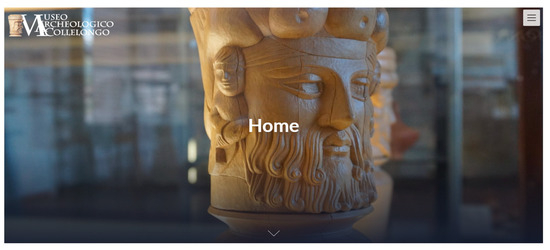
Figure 1.
Landing page—graphical interface.
The website design, realised with the plugin nimble page builder [3], is subdivided into three main sections: the virtual tour, the online catalogue and the web maps (Figure 2).
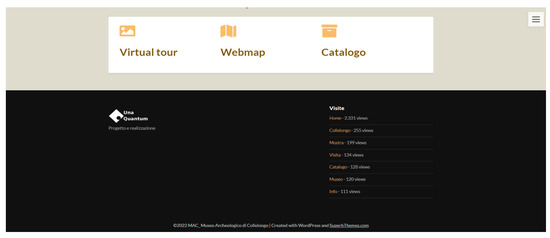
Figure 2.
Website sections.
The virtual tour, which was entirely realised and edited with the open source software Marzipano tool (Marzipano v0.10.2), was further post-produced in order to enrich the base with additional multimedia content [4].
The spherical photographs include pop-ups containing detailed images of the exhibits in the showcases and their respective descriptions (Figure 3).
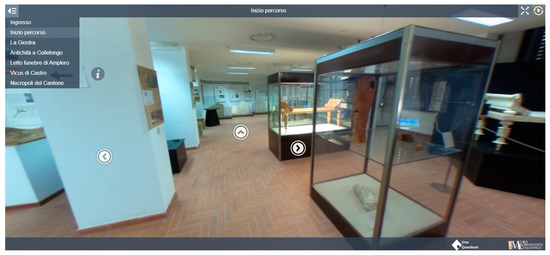
Figure 3.
Virtual tour details, inside the museum’s rooms.
Other pop-ups provide details of the panels in digital format and a navigable digital elevation model, which reproduces the wood scale model located in the ‘La Giostra’ room.
The virtual landscape model, created with QGIS (Quantum geographicaL information system, v3.18, Zürich), uses the DEM (digital elevation model) of the area as a basis, as well as the resources of the qgis2threejs plugin (Figure 4), which displays 3D vectors on web browsers and generates various types of 3D objects and files for publication on the web in a simple procedure. The 3D model can be exported in glTF (graphics language transmission format) format for 3DCG (three-dimensional computer graphics) or 3D printing [5].
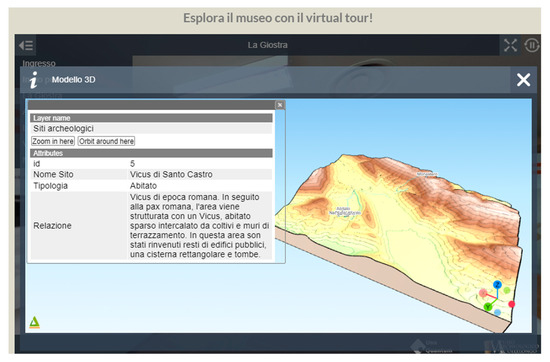
Figure 4.
Visualization in qgis2threejs of the virtual landscape model.
The online catalogue was set up on Omeka, a free open source content manager created specifically for collections, digital archives and online exhibitions [6]. This tool has a good degree of customisation and is characterised in particular by a simple interface and different types of pre-set tabs, which are further customisable depending on the user’s specific needs.
The items are listed with their inventory number, dating and provenances, according to ICCD regulations, and are correlated with detailed photos. The inventory is equipped with a filter that allows for faster and more effective searching of items by type and by timeline. (Figure 5)
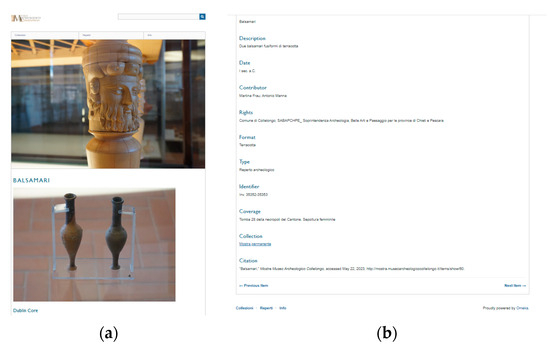
Figure 5.
Online catalogue; (a) item detail photo and (b) item description tab.
The map was produced with QGIS software and reworked for a web format with LeafletJS open-source JavaScript library for mobile-friendly interactive maps [7].
The web map aims to contextualise the preserved museum artefacts in their original places of discovery, and to represent the landscape and naturalistic attractions of the area, showing the main relevant hiking routes and all areas of tourist interest within the municipality, with a focus on archaeological sites.
The WebGIS also features spherical photos that generate a 360-degree view of the cultural and landscape assets shown on the digital chart (Figure 6).
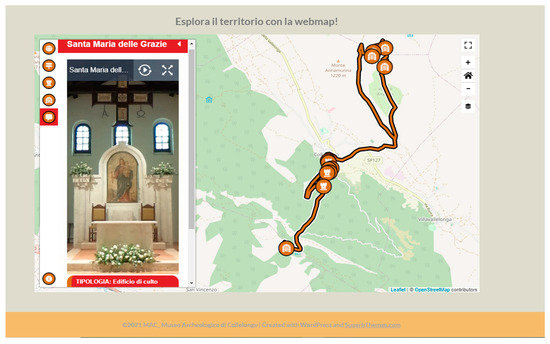
Figure 6.
Web map—detail with a spherical photo of the Church Santa Maria delle Grazie.
Also essential to the project was the realisation of a component to record the number of accesses to the different tabs of the website.
The widget enables the analysis of interactive user flows, which is useful for obtaining an initial assessment of the impact on the online audience (Figure 2).
2.2. Analysis of User Flows
By calibrating these data with those that can be extrapolated from the management of social media pages and those from the museum’s entry register, a statistical model was obtained, which was useful firstly to identify the tool’s dissemination capacity and secondly to orientate tourism promotion strategies.
The annual number of visitors to the museum, affected in recent years by variables that have often influenced the museum’s performance in terms of fruition, indicate that the pandemic restrictions were cushioned by the realisation of a temporary exhibition organised by SABAP (soprintendenza archeologia belle arti e paesaggio), which exhibited artefacts from other necropolises, favouring visits from the surrounding area, especially during the summer period.
The influx in 2019, without any initiatives other than the realisation of the museum’s Facebook page, allowed a good attendance of 23%. After having reached 26% in 2020, there was a sharp decline, also due to the absence of on-site initiatives aimed at engaging visitors, to 7%.
Unfortunately, the Facebook data gives a very narrow view of the flow, probably due to the lack of sponsorship on the page itself.
The above-described picture is given by 343 followers so far, most of whom are between 25 and 44 years old. The class of users between 45–54 years old follows, albeit with a slight decrease.
The comparison of the data obtained from access and interaction with Facebook users with the data from website visits seems to be interesting.
While the social feedback seems to be limited, the impact of the website, in terms of dissemination, seems to have had an effect that, although still assessable in a rather short period (the publication dates back to 2022), already seems to be able to give some indication of the impact on a wider audience.
In terms of spreading, the analysis of the interaction flows allows us to glimpse a good response of approximately 2330 views of the Home webpage, which demonstrates a wide dissemination of the site well beyond the numbers of annual entrances to the museum, which often does not exceed 300 visitors.
The number of visitors who explored the different sections of the website in total reached a far lower number than the number of visitors on the homepage (942 vs. 2330).
These records indicate that it is more accurate to examine the individual sections of the website.
The data on the number of users who experienced the virtual tour of the exhibition and museum return a prevalence of 21% and 27%, respectively.
The data of the other sections (we do not have indicators for the WebGIS at the moment) indicate a preference for the virtual tour and increasing numbers of visits to the other sections (online catalogue 13%, country and monuments 13%, information 12% and contacts for visits 14%) (Figure 7).
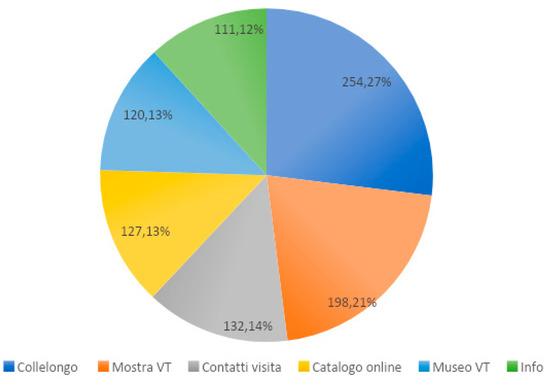
Figure 7.
Comparison of user interaction in website sections, updated on 10.10.2022.
However, there is a clear increase in virtual users, compared to on-site visit data and compared to Facebook users (there are approximately three times as many as website visitors as Facebook users).
3. Results and Discussion
At this stage, it is clear that the statistical model applied to the data makes it possible to assess the effectiveness of the impact of the social media apparatus on an unclassified set of categories of virtual users, despite its limited use.
In this regard, the systematisation of the two tools through a more systematic workflow should bring a more structured impact analysis.
The dissemination processes and the promotional apparatus applicable through preferential channels could involve the user groups most inclined to the context, stimulating a more widespread knowledge of the site and its practical use (i.e., research and knowledge of the territory and shared culture), making it more useful in terms of tourism use than it has been to date.
However, the impact on virtual users seems to be positive in quantitative terms, considering the quality of the tools used; the indices that have been recorded so far show a tendency of growth in the level of use by digital users, even if the definitive results will be more determinable in the future.
4. Conclusions
The impact of the website demonstrates the interest of users in the content of a small, even little-known museum institute.
The quality of the interface and the attention to the user experience is fundamental, and, furthermore, the need to continue the detailed monitoring of the website allows a precise description of the interests of the audience, encompassing a real analysis of the audience through the website.
The use of open source tools allows high performance level with a low cost, which allows even small museum structures, characterised by an endemic lack of economic resources, to improve their digital renovation.
Author Contributions
Planning—organization and conceptualization, P.A.M.; methodology, P.A.M. and E.C.; data collection, P.A.M. and M.F.; Website realization, V.D.L.; Website implementation and design, M.F.; virtual tour production, M.F.; online catalogue production, P.A.M. and M.F.; WebGIS production and post-production, P.A.M. and V.D.L.; user flow analysis, P.A.M. and E.C.; writing—original draft preparation, P.A.M.; writing—review and editing, P.A.M.; project administration and coordination, P.A.M. All authors have read and agreed to the published version of the manuscript.
Funding
The project, having as its purpose the technological renovation and digitisation of the archaeological and environmental heritage of Collelongo (AQ) Italy, was financed by the Municipality of Collelongo through an agreement between the Municipality Council and APS Una Quantum Inc. and approved by Council Resolution Act No. 44 of 08-09-2021 for a full amount of 5000 €.
Institutional Review Board Statement
Not applicable.
Informed Consent Statement
Not applicable.
Data Availability Statement
The data used were extracted from the website www.museoarcheologico.it and the facebook page museoarcheologicocollelongo. The data related to the website users are available at the link https://museoarcheologicocollelongo.it/. The Facebook users data are available at the link https://www.facebook.com/museoarcheologicocollelongo?locale=it_IT.
Conflicts of Interest
Author Valerio De Luca and Martina Frau were employed by the company Una Quantum Inc., 00154 Roma, Italy. The remaining authors declare that the research was conducted in the absence of any commercial or financial relationships that could be construed as a potential conflict of interest.
References
- Letta, C.; Paoletti, M. Amplero: Archeologia e Storia di un Centro Italico-Romano; 20 anni di Ricerche, (Catalogo Mostra, Collelongo 1989)—Palazzo Botticelli, 16 Agosto–31 Dicembre 1989; Studioluce: Sambuceto, Italy, 1989. [Google Scholar]
- Mullenweg, M. WordPress Now. Available online: https://wordpress.org/news/2003/05/wordpress-now-available/ (accessed on 22 July 2010).
- Available online: https://wordpress.org/plugins/nimble-builder/ (accessed on 22 March 2023).
- Available online: https://www.marzipano.net/ (accessed on 22 March 2023).
- Available online: https://buildmedia.readthedocs.org/media/pdf/qgis2threejs/docs/qgis2threejs.pdf (accessed on 22 March 2023).
- Cohen, D.; Introducing Omeka. Digital Humanities Blog » Blog Archive». 20 February 2008. Available online: https://mars.gmu.edu/bitstream/handle/1920/6089/2008-02-20_IntroOmeka.pdf (accessed on 22 March 2023).
- Available online: https://leafletjs.com/ (accessed on 22 March 2023).
Disclaimer/Publisher’s Note: The statements, opinions and data contained in all publications are solely those of the individual author(s) and contributor(s) and not of MDPI and/or the editor(s). MDPI and/or the editor(s) disclaim responsibility for any injury to people or property resulting from any ideas, methods, instructions or products referred to in the content. |
© 2024 by the authors. Licensee MDPI, Basel, Switzerland. This article is an open access article distributed under the terms and conditions of the Creative Commons Attribution (CC BY) license (https://creativecommons.org/licenses/by/4.0/).